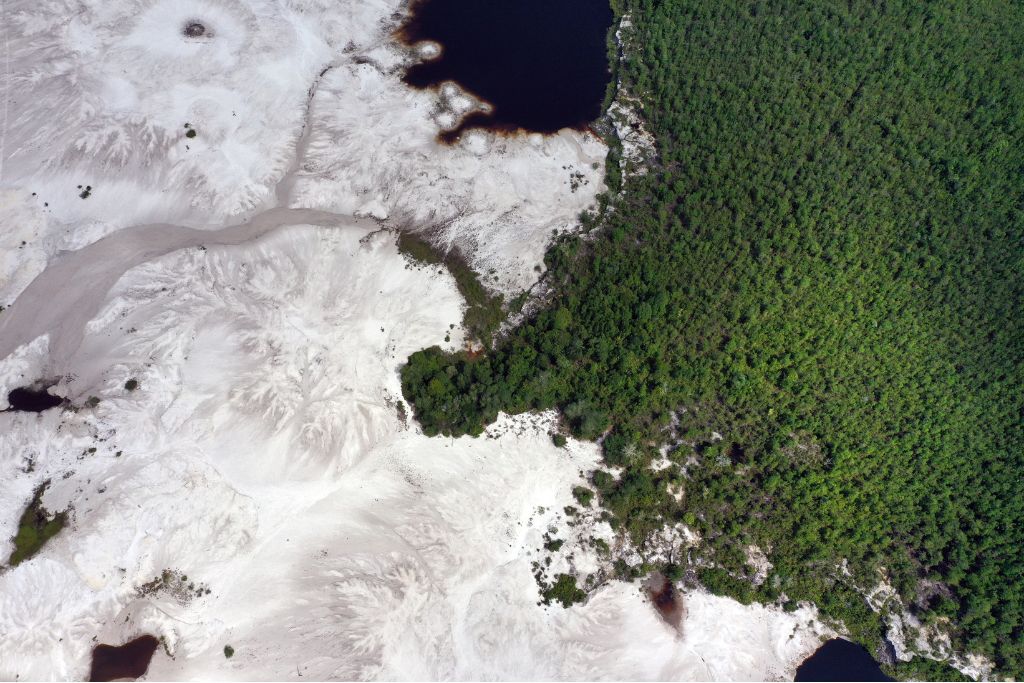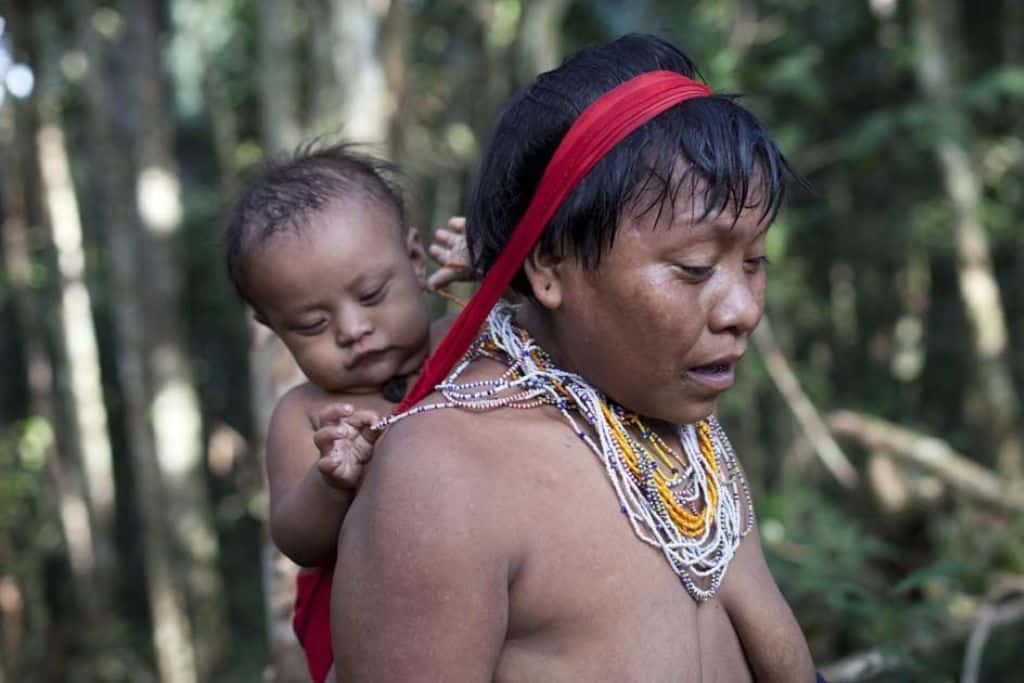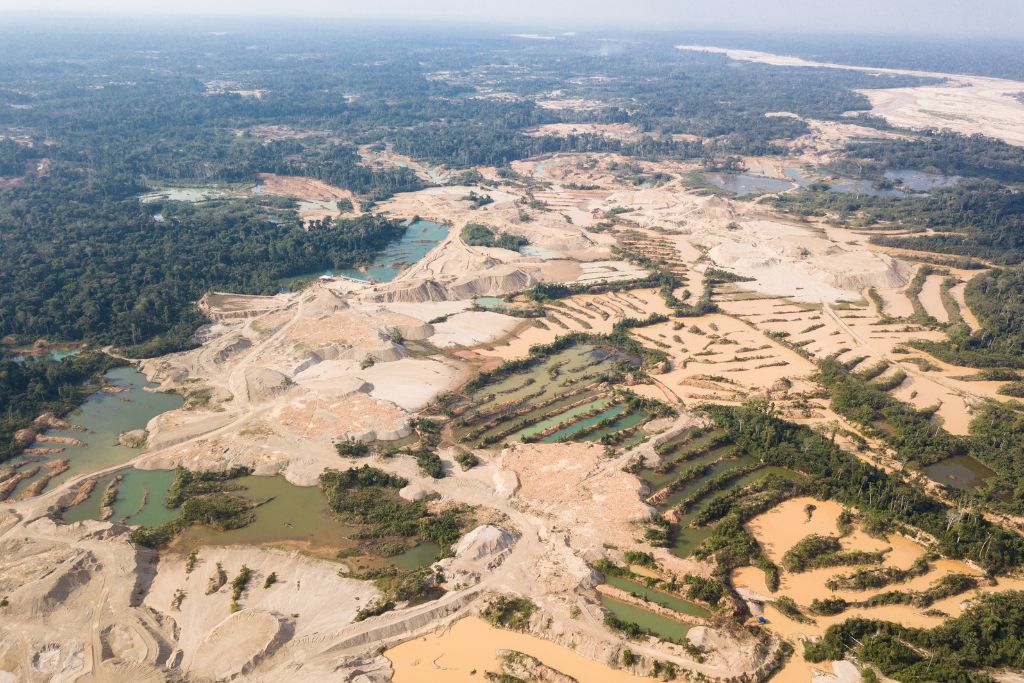Illegal mining has emerged as the “new cocaine” in Latin America, becoming the central target of criminal organizations to finance their activities and expansion. Driven by a new gold rush in the region, this serious environmental crime has left a bleak footprint behind it, driving deforestation, poisoning ecosystems, endangering protected species, and devastating indigenous lands.
—
With gold prices soaring over the past two decades, criminal groups once focused on drug and arms trafficking have moved to illegal mining, an illicit industry that INTERPOL and the United Nations Environment Programme (UNEP) estimate as generating up to $48 billion in criminal proceeds annually.
Gold has become the “new cocaine” in Latin America, more lucrative, easier to launder, and considerably less risky. The UN Office on Drugs and Crime (UNODC) World Drug Report 2019 showed that the value of illegal gold exports exceeded that of cocaine in the two largest cocaine producers, Colombia and Peru. Yet, the rapid expansion of illegal gold mining and trafficking has been accompanied by equally unprecedented damage to the environment, linking transnational criminal organizations to severe environmental crimes.
More on the topic: Explainer: What Is Environmental Crime
The New Gold Rush in Latin America
Illegal mining is a grave environmental crime, the most damaging, rapidly expanding, and profitable criminal activities in the world. As with environmental crimes, illegal mining does not have a universally accepted definition. It commonly refers to mining activities that violate regulatory laws, in restricted areas, and with prohibited equipment and chemicals. As noted by UNODC, the consequences of illegal mining are extensive and far-reaching, negatively impacting the environment, habitats, human and animal life, Indigenous communities and their livelihoods, public health, economies, development, and the rule of law.
Although gold has been traded for millennia, more than half of all gold mined in human history has been mined in just the last 50 years. Gold demand comes from four primary sources: 50.6% is allocated to the jewelry industry, 26.7% to private investments, 15% to central bank assets, and 7.7% to technology companies. Skyrocketing prices and demand for gold across these sectors have sparked a new gold rush in Latin America, leaving a deep environmental footprint.
Illegal gold miners move deeper into forest areas, encroaching on protected areas and indigenous territories and expanding across borders. This poses serious law enforcement challenges. Indeed, illegal gold mining occurs in remote areas with limited state presence and challenging forest landscapes, leading to its unchecked expansion. Furthermore, unlike cocaine, once “laundered,” gold becomes legal and can freely cross international borders to enter the formal consumer market. With the difficulty of tracing the origin of illegal gold, organized crime has access to a convenient flow of criminal proceeds.
The ravages of illegal mining have a significant cost. According to the Brazilian Federal Public Prosecutor’s Office, each kilogram of gold causes R$1.7 million (US$325,000) in environmental damage, around ten times its market price. In Colombia alone, mending the damage caused by mining would cost nearly US$11 billion and take up to 40 years. What’s more, gold mining does not positively impact the socio-economic conditions of the Amazonian population. Mineral extraction fails to guarantee positive changes in local realities long-term, with only brief effects on GDP per capita indicators. On the contrary, mining keeps local populations impoverished, disrupting livelihoods and destroying the environment.
The Perpetrators Behind Illegal Mining
According to the UN, illegal mining serves as a vital avenue for the expansion of non-state armed groups (NSAG), providing a significant revenue stream to militias, warlords, organized criminal groups, and terrorist organizations through the sale of illegally mined minerals. As the World Wildlife Fund (WWF) points out, although the true scale is challenging to assess due to a relatively recent development, criminal organizations have deeply infiltrated gold production chains in the Amazon. This has placed illegal mining as a hub with other criminal offenses, intersecting with organized crime, conflict-related violence, money laundering, forced displacement, human trafficking, environmental damage, and corruption.
Environmental crimes have proliferated in the Amazon basin, which spans nine countries, without regard to national borders. Illegal gold mining is one of the major problems facing all Amazon countries. It causes irreparable damage to forests and rivers, leading to deforestation and contamination across the Amazon. As stated by InSight Crime, it is by far the most widespread and insidious environmental crime occurring in the tri-border regions where the borders of Amazonian countries meet.
Pristine areas in the heart of the Amazon rainforest have been transformed into hotbeds of illegal gold mining controlled by NSAGs. These include the National Liberation Army (ELN), Colombia’s last guerrilla insurgent group, the splinter factions of the Revolutionary Armed Forces of Colombia (ex-FARC), which did not demobilize after the agreement peace with the Colombian government in 2016, the Clan del Golfo, Colombia’s largest drug cartel, and the First Capital Command (PCC), Brazil’s most powerful mafia. The “low risk, high reward” nature of illegal mining, characteristic of environmental crimes, has pushed these criminal and armed groups to exploit gold mining as a source of income, supplementing other illegal activities such as extortion and coca trafficking.
Expanding into areas where the government lacks authority, NSAGs have exercised control over illegal mines with impunity while obtaining significant sources of revenue to finance their expansion and maintain their dominance.
Illegal gold is estimated to account for a large portion of the total gold mining activity of South American countries, accounting for 86% of the gold mined in Venezuela, 80% in Colombia, 70% in Ecuador, 45% in Bolivia, 30% in Peru and 28% in Brazil. These groups have firmly established themselves in neighboring countries and spread beyond national borders. The ELN and ex-FARC, for example, have made significant inroads in Venezuela, moving from Colombian guerrilla status to binational groups and extending their operations throughout the country.
In Venezuela, NSAGs control gold mining sites and routes. While some criminal organisations involved in the mining sector operate independently, the majority are linked to the Maduro regime. Forest areas, national parks, and protected areas alike are targeted for illegal mining activities, often with authorities’ blessing. Gold is mined, laundered, and sold through corrupt channels within the Venezuelan government or dominated by NSAGs, with little regard for environmental damage. Under the national Constitution, Venezuelan gold can only be purchased through the Venezuelan Central Bank, through which illegal gold can thus be channeled “formally.” Nevertheless, two-thirds of all gold extracted is still smuggled out of Venezuela via clandestine routes.
The Environmental Impacts of Illegal Mining
Illegal mining involves environmentally destructive methods that threaten ecosystems and entire communities, depriving local populations of vital resources. This is evident in countries housing the Amazon rainforest, the world’s largest remaining tropical rainforest, home to 10% of the planet’s known biodiversity and 15% of the world’s total river discharge into the oceans. The forest is plagued by rampant deforestation, which increased by 25% in the first half of 2020, mainly due to illegal mining.

Among Amazon Basin countries, Venezuela is the one experiencing the fastest-growing rate of deforestation, primarily owing to illegal mining carried out by guerrilla groups and mining gangs known as sindicatos. Similarly, NSAGs play a significant role in deforestation in Colombia. Here, deforestation increased significantly following the 2016 Colombian peace process, which left a vacuum filled by other groups seeking to exert control over territories previously controlled by the FARC and intensifying their illegal activities. Deforestation due to illegal mining in the country is estimated to be 2.3 times higher than that linked to legal mining. The environmental toll of gold mining is substantial, with an estimated 20 trees being cut down for every kilogram of gold mined.
A large proportion of deforestation occurs on indigenous land, especially in Brazil and Venezuela. Both countries account for 50% and 32% of illegal mining sites, respectively. Notably, in the protected territory of the Yanomami indigenous peoples, on the border between Venezuela and Brazil, satellite images show a 20-fold increase in illegal mining activity between 2016 and 2021. Between 2018 and 2022, deforestation of Yanomami people’s land due to illegal mining rose from 1,236 hectares to 5,053 hectares, a 308.8% jump.
Besides deforestation, one of the most severe environmental consequences of illegal mining is mercury poisoning. Small-scale gold mining is the second-largest source of mercury pollution globally, behind the burning of fossil fuels, alone accounting for around a third of total mercury pollution.
Although highly toxic and hazardous, illegal miners widely use mercury to extract gold from other minerals. It binds to gold particles, forming a heavy amalgam that can be burned to leave only gold. Each gram of gold extracted by illegal mining in Latin America releases an average of 4.63 grams of mercury into waterways. Given that one gram of mercury is sufficient to contaminate a 20-acre lake, the region’s pervasive illegal gold mining causes irreversible environmental degradation. But solid mercury only accounts for 20% of mercury dumped into the environment, with the remaining 80% being released into the air as vapors, affecting the health of surrounding populations.

Artisanal gold miners release tons of mercury into Amazonian rivers and lakes every year, generating levels up to 34 times above the safe limit. This destroys the environment, contaminates water and soil, poisons ecosystems, accumulates throughout the food chain, and harms the health of human populations living as much as 400 kilometers downstream.
The 2013 Minamata Convention, which all Amazon states except Venezuela have ratified, regulates the importation and trade of mercury. This convention is part of international efforts to restrict the use of mercury in industry and manufacturing. However, organized crime persists in illegally trading in the chemical element, smuggling it into countries in the region and fueling mining networks for continued use.
Mining is also devastating for floodplains, the adjacent land areas to a river. Illegal placer gold mining – the extraction of riverbeds and alluvium for mineral deposits – leads to the discharge of large quantities of sediments into rivers. Placer mines stretch on entire floodplains, expanding along the river over dozens of kilometers. The miners upturn the soil’s top layer to uncover the gold-bearing placer sediments, leaving a bleak lunar landscape behind. Illegal placer mining activities have led to at least 350,000 hectares of forest and wetland habitat loss in the Pan Amazon.
In 2021, Greenpeace’s monitoring revealed that illegal mining had contaminated and devastated 632 kilometers of rivers in the Munduruku and Sai Cinza Indigenous Lands in Brazil in just five years. The contamination of rivers by illegal mining has caused irreversible environmental damage to once-pristine environments, as seen with the Tapajos River, one of Brazil’s largest clearwater rivers. Once dubbed Brazil’s “Blue River”, Tapajos has drawn a rush of gold miners since 2019 as environmental enforcement faltered under Jair Bolsonaro’s far-right government. Their illegal activities polluted the river water, turning it brown.
Biodiversity in the Amazon is also at risk, with illegal gold prospectors and miners, called Garimpeiros, preying on protected and endangered species. As many of these species also play essential roles in seed dispersal, seed predation, herbivory and pollination, illegal miners not only endanger their population sizes but also compromise entire ecosystems that depend on each species to function sustainably.
Combating Illegal Mining
Illegal mining’s devastating environmental impact and the involvement of organized crime groups have made it an urgent issue on the international agenda.
In its resolution 2019/23, the UN Economic and Social Council (ECOSOC) recalled the need to develop comprehensive, multifaceted, and coherent strategies and measures to counter illicit trafficking in precious metals and invited member states to take appropriate measures to prevent and combat trafficking in precious metals by organized criminal groups. Additionally, the General Assembly’s resolution 75/196 adopted in 2020 emphasized the substantial increase in the volume, rate of transnational occurrence and range of criminal offenses related to trafficking in precious metals, acknowledging the potential use as a funding source for organized crime.
After four years of Amazon destruction under Bolsonaro, Brazilian president Lula da Silva made cracking down on illegal mining and ending deforestation a top priority upon assuming office in January 2023, after more than 25,000 miners invaded protected Yanomami territories due to Bolsonaro’s disregard for environmental protection rules, allowing a rampant expansion of illegal mining in the Amazon. Lula’s government launched a large-scale campaign to evict illegal miners from Brazil’s largest indigenous reserve and restore control of the Amazon. In the first four months of 2023 alone, Brazilian forces dismantled 340 mining camps and chased miners from 80% of the protected forest they had taken over.

Although the war against illegal mining is far from won, with miners returning after operations were scaled back, Lula stressed that his government will not lose against environmental criminals. Brazil’s commitment to combating illegal mining has resonated in other Latin American countries, such as Ecuador, and led to the execution of the first-ever binational operation in the Amazon with Colombia in December 2023.
You might also like: Lula Orders Crackdown on Illegal Mining in Brazil’s Yanomami Territory, Declares Medical Emergency
In 2019, Peru and the United States launched Operation Mercury, deploying 1,200 Peruvian police, 300 soldiers, and 70 prosecutors to expel 6,000 illegal miners from Madre de Dios, the epicenter of illegal mining in Peru. By 2020, the operation had entirely eliminated illegal mining in the region and reduced deforestation by 92%. The success was made possible by the comprehensive support of the national government, cooperation with external partners to obtain funding and operational backing, the semi-permanent government presence established in the region to prevent the return of organized crime, and an emphasis on economic development and alternative job creation alongside law enforcement efforts.
Although illegal gold mining has returned to protected territories following a law enforcement reduction during the Covid-19 pandemic, Operation Mercury demonstrated its potential as a model for future anti-illegal mining operations in Latin America, complemented by environmental protection and remediation.
The PlanetGOLD program complements these law enforcement operations. Led by UNEP, the initiative collaborates with governments, private sectors, and local communities to promote cleaner and more efficient small-scale gold mining practices while ending illegal activities. In Latin America, Phase 1, which focuses on technical solutions and access to financing, was implemented in Colombia, Ecuador, Guyana and Peru. Phase 2, which focuses on formalizing small-scale gold mining, has been extended to Bolivia, Honduras, Suriname and Nicaragua.
The initiative introduces and facilitates access to alternative mercury-free technologies and best practices, enabling greater returns for miners while posing fewer risks to their health, communities and the environment and thus ensuring that gold is produced under environmental and social standards, allowing miners to access formal markets and benefiting all stakeholders.
This story is funded by readers like you
Our non-profit newsroom provides climate coverage free of charge and advertising. Your one-off or monthly donations play a crucial role in supporting our operations, expanding our reach, and maintaining our editorial independence.
About EO | Mission Statement | Impact & Reach | Write for us


















